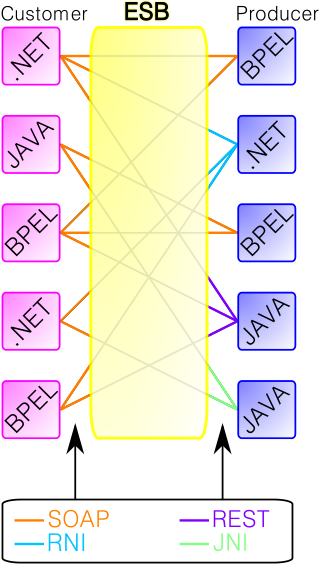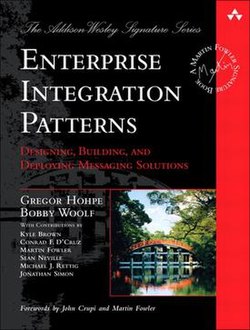In software engineering, a design pattern describes a relatively small, well-defined aspect of a computer program in terms of how to write the code.
In computer science, message queues and mailboxes are software-engineering components typically used for inter-process communication (IPC), or for inter-thread communication within the same process. They use a queue for messaging – the passing of control or of content. Group communication systems provide similar kinds of functionality.
In software engineering, service-oriented architecture (SOA) is an architectural style that focuses on discrete services instead of a monolithic design. SOA is a good choice for system integration. By consequence, it is also applied in the field of software design where services are provided to the other components by application components, through a communication protocol over a network. A service is a discrete unit of functionality that can be accessed remotely and acted upon and updated independently, such as retrieving a credit card statement online. SOA is also intended to be independent of vendors, products and technologies.
Enterprise application integration (EAI) is the use of software and computer systems' architectural principles to integrate a set of enterprise computer applications.

An enterprise service bus (ESB) implements a communication system between mutually interacting software applications in a service-oriented architecture (SOA). It represents a software architecture for distributed computing, and is a special variant of the more general client-server model, wherein any application may behave as server or client. ESB promotes agility and flexibility with regard to high-level protocol communication between applications. Its primary use is in enterprise application integration (EAI) of heterogeneous and complex service landscapes.
In software architecture, publish–subscribe is a messaging pattern where publishers categorize messages into classes that are received by subscribers. This is contrasted to the typical messaging pattern model where publishers send messages directly to subscribers.

In software engineering, coupling is the degree of interdependence between software modules; a measure of how closely connected two routines or modules are; the strength of the relationships between modules. Coupling isn't binary but it's multi-dimensional.
An enterprise messaging system (EMS) or messaging system in brief is a set of published enterprise-wide standards that allows organizations to send semantically precise messages between computer systems. EMS systems promote loosely coupled architectures that allow changes in the formats of messages to have minimum impact on message subscribers. EMS systems are facilitated by the use of structured messages, and appropriate protocols, such as DDS, MSMQ, AMQP or SOAP with web services.
In software architecture, a messaging pattern is an architectural pattern which describes how two different parts of an application, or different systems connect and communicate with each other. There are many aspects to the concept of messaging which can be divided in the following categories: hardware device messaging and software data exchange. Despite the difference in the context, both categories exhibit common traits for data exchange.
A mashup, in web development, is a web page or web application that uses content from more than one source to create a single new service displayed in a single graphical interface. For example, a user could combine the addresses and photographs of their library branches with a Google map to create a map mashup. The term implies easy, fast integration, frequently using open application programming interfaces and data sources to produce enriched results that were not necessarily the original reason for producing the raw source data. The term mashup originally comes from creating something by combining elements from two or more sources.
Java Business Integration (JBI) is a specification developed under the Java Community Process (JCP) for an approach to implementing a service-oriented architecture (SOA). The JCP reference is JSR 208 for JBI 1.0 and JSR 312 for JBI 2.0. JSR 312 was removed from the JCP balloting process on 17 Dec, 2010 by the submitters without being accepted.
IBM App Connect Enterprise (abbreviated as IBM ACE, formerly known as IBM Integration Bus, WebSphere Message Broker, WebSphere Business Integration Message Broker, WebSphere MQSeries Integrator and started life as MQSeries Systems Integrator. App Connect IBM's integration software offering, allowing business information to flow between disparate applications across multiple hardware and software platforms. Rules can be applied to the data flowing through user-authored integrations to route and transform the information. The product can be used as an Enterprise Service Bus supplying a communication channel between applications and services in a service-oriented architecture. App Connect from V11 supports container native deployments with highly optimised container start-up times.
OpenESB is a Java-based open-source enterprise service bus. It can be used as a platform for both enterprise application integration and service-oriented architecture. OpenESB allows developers to integrate legacy systems, external and internal partners and new development in business processes. It supports a multitude of integration technologies including standard JBI, XML with support for XML Schemas, WSDL, and BPEL with the aim of simplicity, efficiency, long-term durability, and low TCO.
Oracle Enterprise Service Bus, a fundamental component of Oracle's Services-Oriented Architecture suite of products, provides integration of data and enterprise applications within an organisation and their connected enterprises.
In computer science, request–response or request–reply is one of the basic methods computers use to communicate with each other in a network, in which the first computer sends a request for some data and the second responds to the request. More specifically, it is a message exchange pattern in which a requestor sends a request message to a replier system, which receives and processes the request, ultimately returning a message in response. It is analogous to a telephone call, in which the caller must wait for the recipient to pick up before anything can be discussed. This is a simple but powerful messaging pattern which allows two applications to have a two-way conversation with one another over a channel; it is especially common in client–server architectures.
A message queueing service is a message-oriented middleware or MOM deployed in a compute cloud using software as a service model. Service subscribers access queues and or topics to exchange data using point-to-point or publish and subscribe patterns.

Guaraná DSL is a domain-specific language (DSL) to design enterprise application integration (EAI) solutions at a high level of abstraction. The resulting models are platform-independent, so engineers do not need to have skills on a low-level integration technology when designing their solutions. Furthermore, this design can be re-used to automatically generate executable EAI solutions for different target technologies.
In the context of software engineering and software architecture, service granularity is a key design concern when applying the paradigm of service-orientation for instance during service-oriented modeling. Service granularity specifies the scope of business functionality and the structure of the message payload in a service operation that is provided within a service-oriented architecture (SOA).
Middleware is a type of computer software program that provides services to software applications beyond those available from the operating system. It can be described as "software glue".



